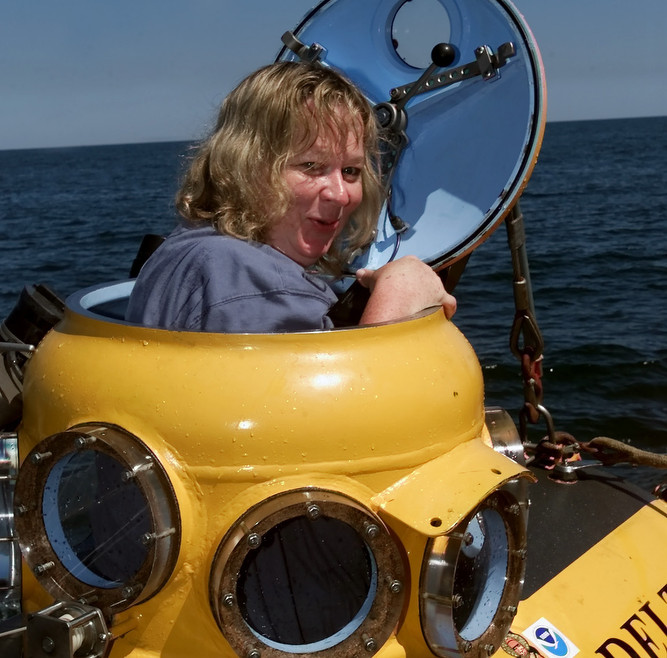VOYAGE TO THE BOTTOM OF THE SHORE
The bottom of the Atlantic Ocean is a neon green world teeming with life. About 5 inches from my nose, a purple sea anemone resembling a miniature palm tree undulates, sucking in tiny specks of light called zooplankton.
A thumb-size cancer crab dances sideways. A pudgy sea robin stops and flutters, as if it knows it’s being videotaped. It preens for a few seconds in front of us, then moves along.
PHOTOS BY ANDREW MILLS/THE STAR-LEDGER
Caption: The Delta returns from where no other submarine, yellow or otherwise, has gone before, down near the Manasquan Ridge. Below, fresh from the ocean floor, it’s The Star-Ledger’s science writer, who is accustomed to a little more elbow room.
We are about 100 feet below the surface of the Atlantic Ocean near the Manasquan Ridge, a glorified sandbar about seven miles east of Point Pleasant Beach. The dive is part of a Rutgers University research expedition to study sea life in an area that has never before been explored.
I am flat on my stomach, stretched along the bottom of a tiny, two-person yellow submarine, pressed against a front porthole. Seated just above my knees on a low stool is the pilot, 25-year-old Joe Lilly, who looks through another forward window.
All before us is serene. Getting down here, though, was no day at the beach.
Before the dive, the 4,800-pound sub was suspended by a hydraulic knuckle-boom crane and lashed to the side of a work boat, the 110-foot Atlantic Surveyor. To enter the sub, you have to climb to the side of the boat, step on top of the curved, smooth-surface sub without falling overboard, and shimmy through its 24-inch-wide hatch.
I’m 5-foot-7 and what my mother lovingly describes as zaftig, so that’s no easy task. Once inside, you must fold your body as if tying shoes, thrust your legs behind you and yank yourself forward with your elbows. Then the pilot scoots in. It’s a tight fit.
Kenneth Able, a Rutgers University biologist in charge of the research project, has spent hundreds of hours in the tiny, steel-hulled Delta. He and another Rutgers biologist, Janice McDonnell, have persuaded me to give it a try.
”I just can’t wait to get in the sub every time. I’m so excited about what I’m going to see,” Able said.
Hmmm.
With a low thud, Lilly seals the hatch. “Ready below, ready to go,” he radios to the ship’s captain, Kurt Perl. The winch whines as we are lowered to the sea surface. Behind me, Lilly pulls knobs and flips switches, and the sub hums with life.
For a few nauseating moments, the water fills up an air pocket between twin layers of glass in the front porthole – providing ballast, I am quickly told. The air grows hot and sticky. The light in the sub turns an eerie, frothy green as we dip below the surface.
I feel as if I have just climbed on the roller coaster at Seaside Park, anxious, not in control. I know everything will turn out fine but I’m nervous anyway. Through the glass, the sea world is an endless, formless mint green. I feel dizzy.
Lilly says we are descending rapidly, but it’s impossible to discern any movement. It seems as if we are floating. The noises are incredible – the kind of loud gurgling that reminds me of the old television show “Voyage to the Bottom of the Sea.”
In a minute, we land on the sea floor, soft as a pillow. We bounce gently up. The scene before us instantly clears, as if someone had turned a knob on a television to sharpen the image.
All my anxiety melts away, too, as my attention is drawn beyond the sub to the great expanse. It’s alive out there. No trash, no silt, no sludge. Just gentle hillocks of clean sand littered with starfish, sand dollars, crabs, anemones and darting fish. I could be in a small airplane flying low over a desert dotted with palm trees.
Up on the ship, the scientists are in close communication with us. Able is listening, via a microphone that sits at the sub’s front, to my description of the panorama. He will watch a videotape of what I have seen when we return from the 15-minute voyage.
Off and on for the past 10 years, Able has been trying to discern whether this edge of the continental shelf is biologically important. The sand at this part of the ocean bottom is regularly mined for beach replenishment. No one knows whether that is destroying a habitat vital to the ecosystem of marine life, especially fish.
”We know less about what happens on the bottom of the ocean than we know about any other habitat on Earth,” Able said.
In recent years, as beach replenishment efforts have intensified, he has redoubled his efforts to see whether this series of undersea ridges along the East Coast is vital to fish populations.
On this Wednesday, three Rutgers scientists who would have joined him have surrendered their berths to an unusual contingent – 13 schoolteachers, the stars of a Rutgers summer enrichment program focused on marine life. All have taken dives in the Delta and emerged with tales of sea rays and sand crabs and real data for Able.
Marge Selfridge of Tuckerton Elementary School wept with joy when she climbed out of the sub. Ann Farr Marchioni of Bloomfield Middle School jumped out exultant: “I did it! I did it!”
”For every one teacher who has this experience,” Able said, “there will be 1,000 more schoolkids who will benefit as well.”
At the ocean bottom, time travels quickly. Before we know it, we are being summoned by radio. Since we touched bottom, 14 minutes have slithered by. Lilly nudges two black knobs, and air whooshes out from the sub, making us too light to stay down.
We emerge rapidly, though I can’t feel it, until we pop up on the water’s surface, the way the space capsules do after splashdown.
We are “topside.” I have always wanted to be able to say that.
Copyright © 2000 The Star-Ledger. All rights reserved. Reprinted with permission.



